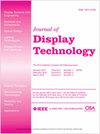Impact of Long-Term Stress on the Light Output of a WRGB AMOLED Display
Q Engineering
引用次数: 5
Abstract
This paper describes how long-term use impacts the light output of a commercial 55” WRGB AMOLED display with InGaZnO TFT backplane. This covers effects which are known by the terms “aging”, “image-sticking,” and “burn-in.” The focus is on three different observations: permanent change in light output as a function of time, permanent screen burn-in, and permanent shift in color point. From this work it can be concluded that state-of-the-art OLED displays still suffer from light output instability under prolonged stress. The results suggest that the permanent change in light output can be explained by the combination of three different phenomena: a decrease in efficiency of the OLEDs as a function of time for active subpixels, a positive threshold voltage shift of the driving transistor for active subpixels, and a negative threshold voltage shift of the driving transistor for inactive subpixels, if they are illuminated and/or kept at high temperature. To our knowledge, this is the first work that describes and quantifies the permanent change in light output of a commercial WRGB OLED panel with InGaZnO TFT backplane. It sheds light on which effects occur and can be a valuable tool, both in the design and optimization of OLED panels and in the determining the circumstances under which this technology may be applicable.长期应力对WRGB AMOLED显示器光输出的影响
本文介绍了商用55英寸WRGB AMOLED显示器的InGaZnO TFT背板的长期使用对光输出的影响。这涵盖了所谓的“老化”、“图像粘贴”和“老化”。重点关注三种不同的观察结果:光输出随时间的永久变化、屏幕永久老化和色点的永久偏移。从这项工作可以得出结论,最先进的OLED显示器在长时间的应力下仍然存在光输出不稳定性。结果表明,光输出的永久变化可以通过三种不同现象的组合来解释:有源子像素的OLED效率随时间的函数降低、有源子像素驱动晶体管的正阈值电压偏移和无源子像素驱动晶体管的负阈值电压偏移,如果它们被照明和/或保持在高温下。据我们所知,这是第一项描述和量化具有InGaZnO TFT背板的商用WRGB OLED面板光输出的永久变化的工作。它揭示了哪些影响会发生,在OLED面板的设计和优化以及确定该技术可能适用的环境中都是一个有价值的工具。
本文章由计算机程序翻译,如有差异,请以英文原文为准。
求助全文
约1分钟内获得全文
求助全文
来源期刊

Journal of Display Technology
工程技术-工程:电子与电气
CiteScore
1.50
自引率
0.00%
发文量
0
审稿时长
2.8 months
期刊介绍:
This publication covers the theory, material, design, fabrication, manufacturing and application of information displays and aspects of display technology that emphasize the progress in device engineering, design and simulation, materials, electronics, physics, and reliability aspects of displays and the application of displays. The Journal is sponsored by EDS, seven other IEEE societies (BT, CES, CPMT, IA, IM, PHO and SSC) and the Optical Society of America (OSA).
 求助内容:
求助内容: 应助结果提醒方式:
应助结果提醒方式:


